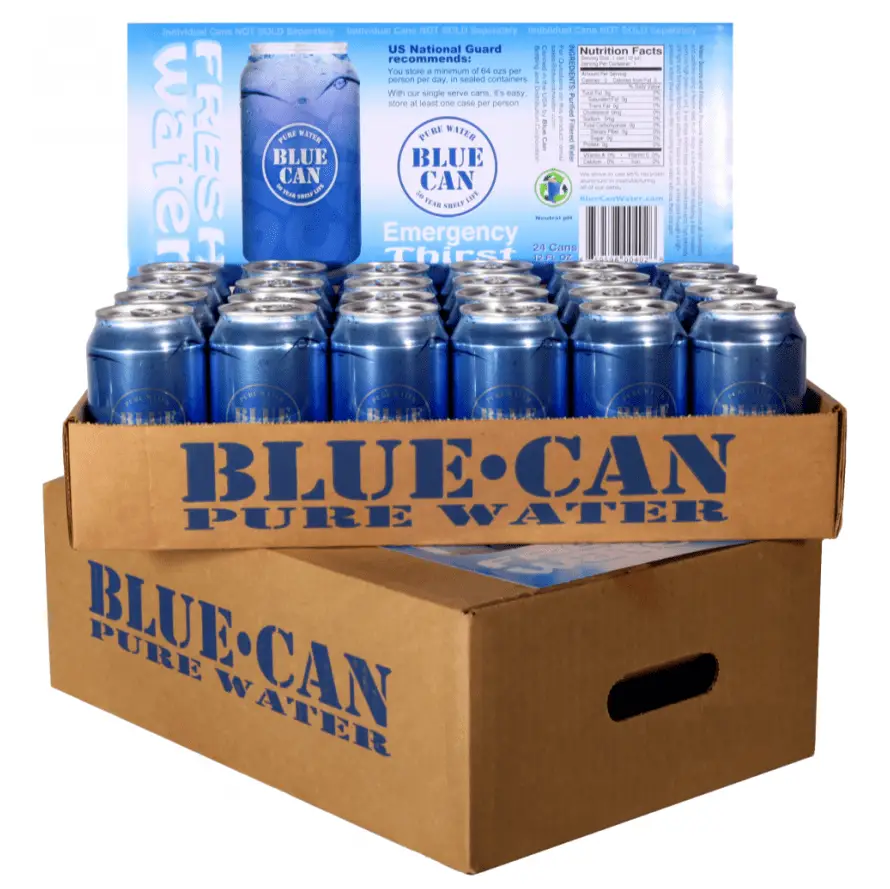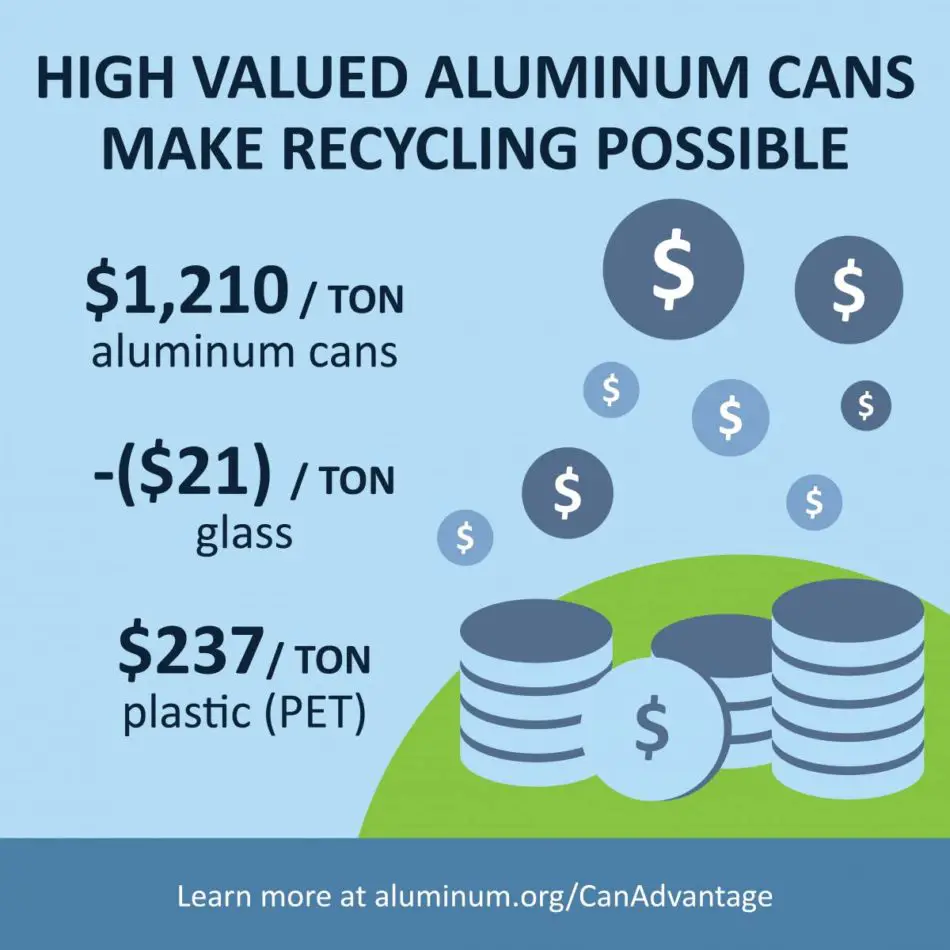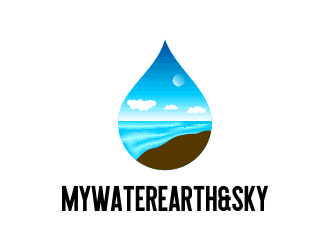According to the Federal Emergency Management Agency (FEMA) and the American Red Cross, individuals should drink at least a half gallon (64 oz.) of water per day in an emergency situation. When you are planning on Emergency Preparedness, water should be a #1 consideration and Canned Water is slowly becoming the Prepper’s #1 choice for Emergency Water Storage. How long does Canned Water Last?
Canned Water has a Shelf Life of 30 to 50 years used by NASA and FEMA is first sterilized, filtered & comes in an aluminum container that is easily recycled, non-permeable bottles, & hermetically sealed that keep out UV light, & contaminants, and gases that prevent oxidation for many years.
Depending on the brand or where it is purchased, bottled water can cost up to 10,000 times the cost of tap water but with canned water, that price is a drop in the bucket and can go up much higher. With Emergency Preparedness in a lot of people’s minds, these days is there a market for this expensive way of packaging and storing the most important item on your emergency list?
Introduction:
Canned water is becoming increasingly popular as a trustworthy and long-lasting source of hydration, particularly in emergencies. Unlike standard bottled water, canned water is crafted to have a longer shelf life, making it a top choice for disaster preparedness, outdoor adventures, and long-term storage. It’s vital to understand how long canned water can last and the factors that influence its shelf life to ensure your supply remains safe and drinkable. This guide provides an overview of the longevity of various types of canned water, helping you make informed decisions about how to store and use it.
How Long Does Canned Water Last

When it comes to Bottled water, the container and packaging have always been an issue when researchers found what kind of chemicals were involved in making plastic drinking water bottles and how long it took for one plastic water bottle to degrade.
Different kinds of plastic can degrade at different times, but the average time for a plastic water bottle to completely degrade is at least 450 years. It can even take some bottles 1000 years to biodegrade in landfills. Even the smallest water bottle. The sad news is that 90% of water bottles aren’t even recycled.
Some water companies have launched survival water in cans, offering a more environmentally sustainable alternative to plastic water bottles. Canned water is drinking water, including spring water, artesian spring water, purified water, sparkling water, and mineral water, packaged in beverage cans made of aluminum or tin-plated steel. Individual serving aluminum cans and water bottles are less common alternatives to bottled water and cans of water.
Plastic Pollution mainly from plastic water bottles is a huge global threat to our oceans and our landfills. Over 1 million plastic water bottles are used every minute. Many water bottles end up in our oceans, polluting the water and harming sea life. We think plastic has got to go. Aluminum cans and bottles get recycled 67% of the time.
That is more than twice as often as plastic, glass, and cartons. Pepsi started its production of Survival Canned Water back in 2019.
Recycling plastic is more complex, leads to degradation, and has lower reuse rates than aluminum because of these and other reasons, Aluminum has been heralded as a greener alternative.
To create a comprehensive table showing how long canned water lasts, we’ll need to consider different factors such as the type of canned water, storage conditions, and whether the can is opened or unopened. Here’s an example table:
Key Points:
- Unopened canned water: Generally lasts indefinitely if stored properly in a cool, dark place. However, some manufacturers may specify expiration dates, especially for emergency canned water.
- Opened canned water: Should be consumed within a few days and kept refrigerated to maintain freshness.
- Storage conditions: Always store canned water in a cool, dark place to ensure longevity. Avoid exposing the cans to extreme temperatures or direct sunlight.
This table provides a general guideline. Always check specific manufacturer recommendations, especially for emergency canned water and flavored varieties.
Why is Canned Water Better for Water Storage
Canned Water is expensive especially if you compare it to a case of Bottled Water. I can buy a case of 24 plastic Water Bottles for less than $5.00 at Walmart or any large outlet but Canned Water is around $30.00-100.00 for a case of 24 cans. There are reasons for this and according to a lot of people they are solid reasons:
- Eco-friendly-Canned water is Eco-friendly and uses more sustainable packaging made of 100% recyclable
- No Chemicals-Aluminum doesn’t use chemicals in the container- BPA stands for bisphenol A, an industrial chemical that has been used to make certain plastics and resins since the 1950s. BPA is found in polycarbonate plastics and epoxy resins. Polycarbonate plastics are often used in containers that store food and beverages, such as water bottles. They may also be used in other consumer goods.
- Long-Term Storage – have the ability for long-term storage as emergency water cans when stored in a dry environment with ambient temperatures (above 35 degrees and below 90 degrees Fahrenheit) will last for much longer.
- Infinitely Recyclable aluminum cans be recycled over and over without losing quality or volume and do better unlike plastic water bottles and cartons.
- Better Protection cans when stored for long periods do better and are protected against rodents that plastic water bottles can’t ensure. Water Cans are structurally sturdy and stack extremely well in off-grid locations or storage units and do last for decades.
- Longer Shelf Life-30 to 50-year canned water you will no longer have to repeatedly spend money on replacing it. Canned Drinking Water is perfect for Preppers in this age of awareness when Emergency Preparation of food and water storage is an important plan.
- 3X the Money-recycled aluminum content does reap more money than estimates for glass or plastic with 73 percent recycled content on average,
Do Cans of Water Have a Long Shelf Life
Emergency Canned Water
Canned Water has a Shelf Life of 30 to 50 years used by NASA and FEMA is first sterilized, filtered & comes in an aluminum container that is easily recycled, non-permeable bottles, and hermetically sealed to keep out UV light, and contaminants, and gases (Plastic Water Bottles can’t do this) that prevent oxidation for many years. If open the water taste fresh as the day you bought it. The shelf life of canned water is determined by the brand but lasts much longer than plastic bottled water.
Blue Can Water
The long-term Canned Water that can be stored for 50 years and is popular with Preppers and anyone interested in Emergency Preparedness is Blue Can Premium Emergency Drinking Water – 12oz 24 Pack available here through Amazon. Buy drinking water by the case to get your supply going while you can get this price for a case.
Canned Water Storage vs Emergency Bottled Water
According to the Aluminum Association: aluminum can be recycled infinitely without losing quality or volume. According to the Aluminum Association: “Aluminum cans are recycled over and over again in a true “closed loop” recycling process. Glass, plastic, and cartons are typically “down-cycled” into products like carpet, energy-intensive building materials like concrete, disposable paper goods, or landfill liner.” So, while other containers may claim to be “recyclable,” aluminum alone can be used again and again (and again) without degrading.
 The Aluminum Association, located in Arlington, Virginia, works globally to aggressively promote aluminum as the most sustainable and recyclable automotive, packaging, and construction material in today’s market. The Association represents the U.S. and foreign-based primary producers of aluminum, aluminum recyclers, and producers of fabricated products, as well as industry suppliers. Member companies operate more than 200 plants in the United States, with many conducting business worldwide.
The Aluminum Association, located in Arlington, Virginia, works globally to aggressively promote aluminum as the most sustainable and recyclable automotive, packaging, and construction material in today’s market. The Association represents the U.S. and foreign-based primary producers of aluminum, aluminum recyclers, and producers of fabricated products, as well as industry suppliers. Member companies operate more than 200 plants in the United States, with many conducting business worldwide.
Nearly 75 percent of all aluminum ever produced is still in use today while plastic water bottles last much longer that are littering landfills and our water from
streams to our oceans with the new “Plastic Pollution” that has been developed since plastic developed over the last century but its increasing usage, especially with the growing popularity of Bottled Drinking Water.
Unlike plastic water bottles, Aluminum recycling happens in as little as 60 days. That’s right, the turnaround time for aluminum recycling is super quick. Aluminum can be thrown away, recycled, and back on store shelves in a few months. With recycling that fast, you may have actually used the same can (or part of it) multiple times. Canned water’s longest-year shelf life can last as an emergency item for ten years or more. Drinking water should always be part of your survival food supply.
Aluminum packaging contains an average of 73% post-consumer material. Compare that to plastic, which on average uses just 3% recycled material. Glass is better at 23% but can’t compare to the products of today that consume aluminum compared to other materials.
Aluminum can scrap is worth $1,210 per ton on average versus $237 per ton for plastic (PET) and –$21 per ton for glass. That is the reason it’s worth the effort of recycling where there is real profit for the venture where it might be harder to find when recycling plastic or glass.
How Long Do Water Plastic Bottles Last For Emergency Water Storage
Emissions associated with transporting and cooling aluminum cans are 7 to 21 percent lower than plastic bottles and 35 to 49 percent lower than glass bottles used in the industry.
According to the FDA, Bottled water is safe to drink for at least 2 years if under certain provisions, unlike Canned Water which can last up to 30- 50 years’ shelf life which is an important quality for Preppers who should find that this fact would justify the money it cost.
A new Comprehensive Life Cycle Assessment (LCA) by sustainability consultancy Sphera shows that the carbon footprint of aluminum cans made in North America has dropped by nearly half over the past three decades put out by the Aluminum Association
Do Emergency Water Cans Last Long
On some Canned Water, especially the drinking water cans that are stored for survival in Emergency Preparedness, you can’t reseal them drinking water cans. They are built with a pop-top to open them up. On plastic bottles, you can put the cap back on.
Doing this prevents contaminants from getting into the water, increases portability, and preserves the freshness of the water stored in emergency food. Cans of water cannot be resealed once they are opened, so the entire contents of the water can have to be used at one time or placed into a storage container
Emergency water storage drinking water in plastic bottles and aluminum cans is made using different types of materials. Plastic water bottles stored as survival emergency food require large amounts of petroleum to produce. These products are made from chemicals that are now deemed unhealthy, especially in storage over long periods.
Aluminum Water Cans do not contain bisphenol A (BPA), found in plastic bottles. This chemical has come under scrutiny due to a possible link to health risks that might include cancer. Most plastic bottle manufacturers insist that plastic bottles are safe, but consumer advocate groups support legislation that would ensure the removal of BPA from plastic water bottles.
Aluminum Canning Used for Water Stored Emergency
Aluminum Cans used for water, beer, or soft drinks have been around for a while. The use of aluminum cans and canning was first introduced to the general public in 1959 by Coors in Cans. Aluminum water cans offered an affordable alternative to steel as well as a more convenient surface for company-printed text and graphics.
Aluminum water or soda cans can be recycled into more cans in a true “closed-loop” recycling process and can last as water stored for decades, an answer for emergency kits’ survival water storage.
You can store water for ten years, or more water should last much longer than water stored in bottled containers for water. storage. Emergency drinking water and sparkling water should keep and last for a long time on the shelf.
Store canned water for drinking in survival situations instead of plastic water bottles in survival kits or even bug-out kits with survival food on boats or cabins. For longer food storage supply.
Aluminum does not occur in nature and is primarily comprised of bauxite rock, which is primarily found in Australia, India, and Brazil. Collecting bauxite comprises open-pit mining, which usually involves moving or bulldozing large amounts of vegetation and surface rocks.
This type of mining negatively affects ecosystems and creates air and water pollution, which can cause health issues for wildlife and humans. Drinking water packaged in Aluminum cans would complete the emergency water check-off list.
So there are negatives to the manufacturing processes of both Plastic and Aluminum Cans used for water storage, survival kits, and emergency kits but the main health issue is the worry that BPA found in plastic Bottled water leaches into the human body and the environment as waste in landfills and oceans.
Canned water with a shelf life for decades along with your food storage and other emergency kits you keep for complete survival.
- Puravai Emergency Drinking Water comes with a 20-year guaranteed shelf life but water will keep is safe to drink beyond 50 years when stored properly. This case of Puravai Emergency Drinking Water comes with 6 one-liter bottles (33.8 fluid ounces) of the longest-lasting, most durable, and most convenient water available.
- Blue Canned Emergency Drinking Water-how long does Blue supply emergency water last in survival life? Blue Water has a 20-50 year shelf life.
Conclusion:
When stored properly, canned water can last indefinitely, making it an excellent choice for long-term storage, particularly for emergencies. However, the shelf life can vary based on the type of water and the conditions in which it’s stored. Unopened cans typically retain their quality for years, but it’s important to consume opened water within a few days to ensure it stays fresh. Always store canned water in a cool, dark area and check the manufacturer’s guidelines for specific recommendations, especially for flavored or emergency varieties. Proper storage and timely consumption are essential for maximizing the longevity and quality of canned water.
How To Tell If Water is Safe To Drink in the Wild
For informative educational articles like this one on canned water stay here at MyWaterEarth&Sky-Crystal clear water, running through a stream or river does get cleaned a bit by natural processes flowing over rocks, vegetation, and other natural filters. But, if you are drinking …………………………………………………………….. Continue reading
References:
The Aluminum Association-Carbon Footprint of Aluminum Cans
Sciencing-Plastic Bottle Vs. Aluminum Can
In Habitat-Aluminum cans vs. plastic bottles: which is best for the environment?
FAQ’s
How long does canned water last?
- Unopened canned water can last indefinitely if stored properly in a cool, dark place. However, some varieties, especially emergency canned water, may come with a manufacturer-specified shelf life of 30-50 years.
2. Can canned water expire?
- Technically, water itself does not expire, but the quality of the container and the seal can affect the water’s taste and safety over time. Check for any manufacturer-provided expiration dates, particularly for emergency canned water.
3. What happens if I drink expired canned water?
- Drinking expired canned water is generally safe if the can is undamaged and stored correctly. However, the water may taste stale, and there is a slight risk of contamination if the can has degraded or been compromised.
4. How should I store canned water?
- Store canned water in a cool, dark place away from direct sunlight and extreme temperatures. This helps prevent the can from rusting or degrading and maintains the water’s quality.
5. Can I drink canned water after opening it?
- Yes, but once opened, canned water should be refrigerated and consumed within 1-3 days, depending on the type of water (still, sparkling, flavored).
6. Does canned sparkling water lose its carbonation over time?
- Canned sparkling water can lose its carbonation over time, especially after opening. It’s best to consume it within 1-2 days after opening to enjoy its full fizz.
7. Is canned water safe for emergency preparedness?
- Yes, canned water is ideal for emergency preparedness due to its long shelf life and durability. Emergency canned water is specifically designed to last for decades, making it a reliable choice for disaster kits.
8. Why does emergency canned water have such a long shelf life?
- Emergency canned water is specially packaged with durable materials and sealed in an oxygen-free environment to prevent contamination and degradation, giving it a shelf life of 30-50 years.
9. Can I use canned water for cooking?
- Yes, canned water is perfectly safe for cooking, just like bottled or tap water. Simply open the can and use it as you would with any other water source.
10. What should I do if a can of water is damaged or rusted?
- If a can of water is damaged, rusted, or has a compromised seal, it’s best to discard it to avoid potential contamination.



